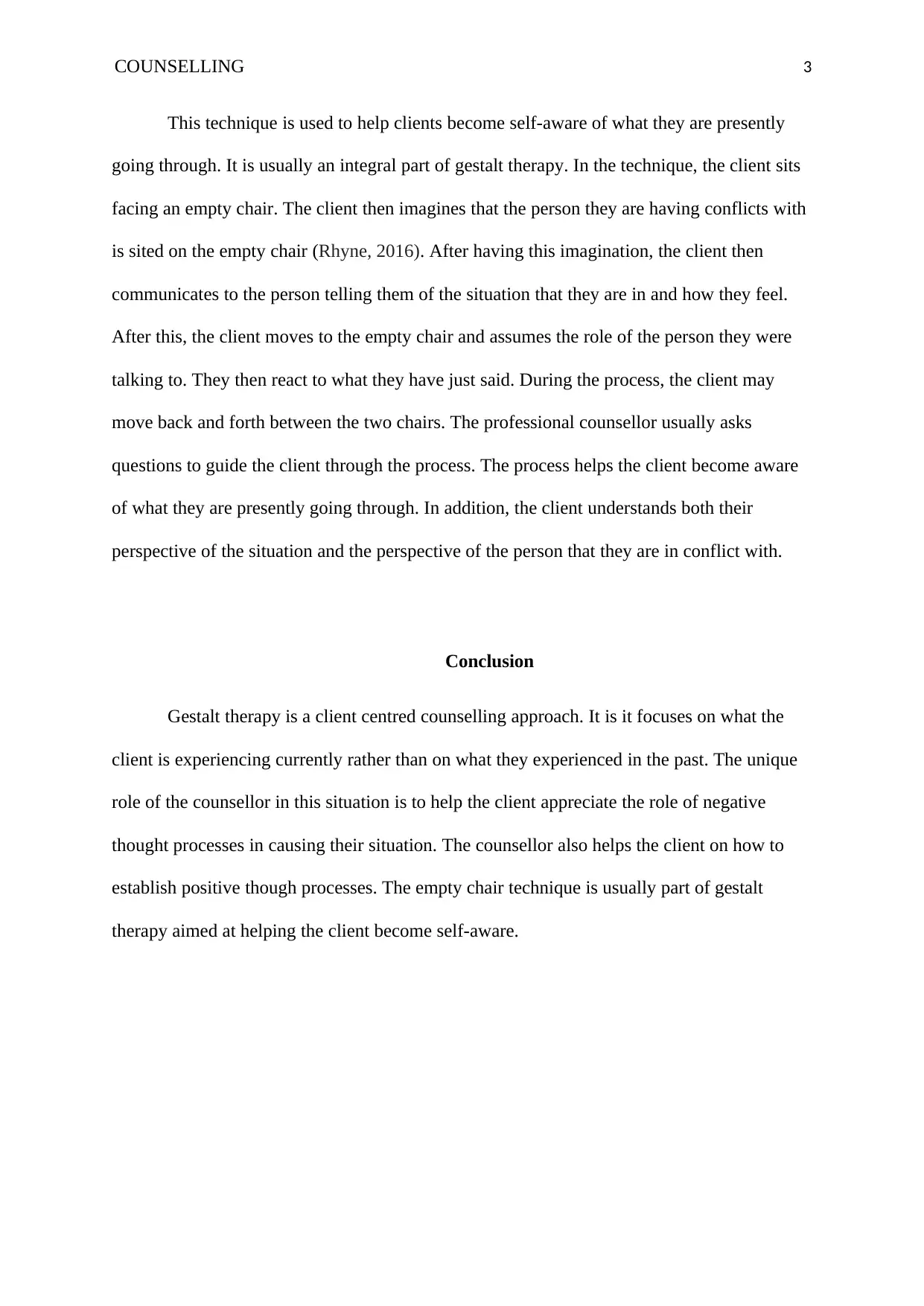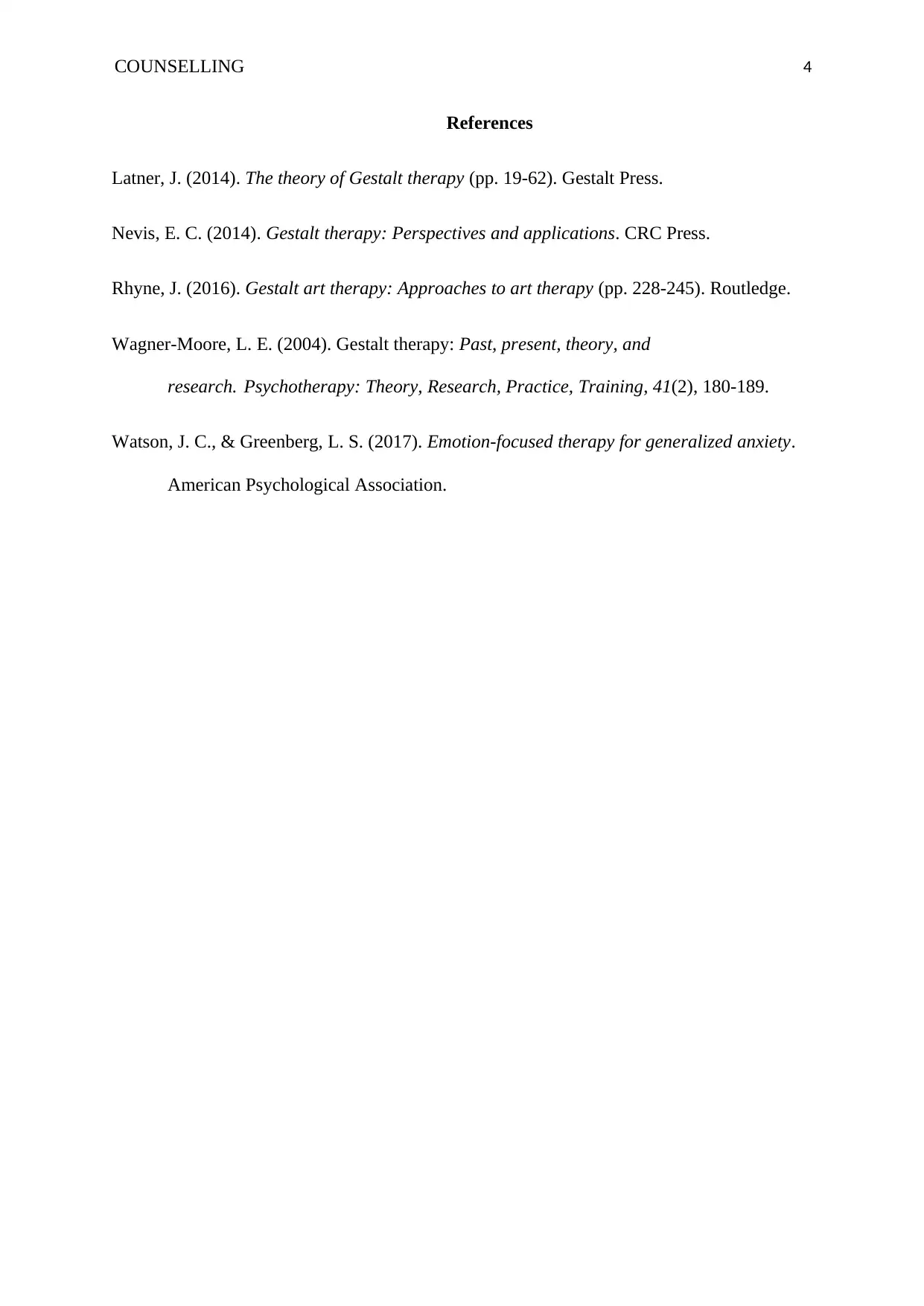An Overview of Gestalt Therapy and the Empty Chair Technique
VerifiedAdded on 2023/05/29
|4
|717
|201
Essay
AI Summary
This essay provides an overview of Gestalt therapy, a client-centered counselling approach that emphasizes present experiences over past events. It highlights the importance of self-awareness in overcoming negative thought patterns and improving mental well-being. The empty chair technique, a key component of Gestalt therapy, is discussed in detail, explaining how it helps clients understand their own perspectives and those of others in conflict situations. The essay concludes by emphasizing the counsellor's role in guiding clients towards positive thought processes and self-discovery. Desklib offers a wealth of resources, including past papers and solved assignments, to support students in their academic pursuits.

Running head: COUNSELLING
Counselling
Student’s Name
Institutional Affiliation
Counselling
Student’s Name
Institutional Affiliation
Paraphrase This Document
Need a fresh take? Get an instant paraphrase of this document with our AI Paraphraser

COUNSELLING 2
Counselling
Introduction
Gestalt therapy is a counselling technique that focuses on helping the client become
aware of what they are going through currently (Latner, 2014). The goal is to make the client
self-aware of the negative impacts of negative thought processes and importance of positive
thoughts. The empty chair technique is usually a part of the gestalt therapy aimed at helping
the client become self-aware. Self-awareness is key to recovery (Wagner, 2004)
Gestalt Therapy
Gestalt therapy is one of the psychotherapy techniques that uses a client centred
approach. The approach employed here is unique because it focuses on what the client is
experiencing at the moment rather than their past experiences (Watson and Greenberg, 2017).
Instead of just focusing in what happened in the past, the approach helps the clients
experience the events of the past through such processes as re-enactment. The main goal of
this counselling approach is to help a client become aware of the detrimental effects of
negative thought patterns. After appreciating the role of negative thoughts in making them
unhappy, then the counsellor may guide the client through becoming aware of importance of
positive thoughts. Gestalt therapy may help clients suffering from such conditions as anxiety,
depression and difficulties in relationship (Nevis, 2014). It may also help alleviate physical
problems such as migraines in cases where they are of psychological origin. The therapy is
best suited for people who are willing to solve the issue affecting them through but they are
not aware of what is causing those issues. The counsellor guides such persons through the
process of becoming self-aware.
Empty Chair Technique
Counselling
Introduction
Gestalt therapy is a counselling technique that focuses on helping the client become
aware of what they are going through currently (Latner, 2014). The goal is to make the client
self-aware of the negative impacts of negative thought processes and importance of positive
thoughts. The empty chair technique is usually a part of the gestalt therapy aimed at helping
the client become self-aware. Self-awareness is key to recovery (Wagner, 2004)
Gestalt Therapy
Gestalt therapy is one of the psychotherapy techniques that uses a client centred
approach. The approach employed here is unique because it focuses on what the client is
experiencing at the moment rather than their past experiences (Watson and Greenberg, 2017).
Instead of just focusing in what happened in the past, the approach helps the clients
experience the events of the past through such processes as re-enactment. The main goal of
this counselling approach is to help a client become aware of the detrimental effects of
negative thought patterns. After appreciating the role of negative thoughts in making them
unhappy, then the counsellor may guide the client through becoming aware of importance of
positive thoughts. Gestalt therapy may help clients suffering from such conditions as anxiety,
depression and difficulties in relationship (Nevis, 2014). It may also help alleviate physical
problems such as migraines in cases where they are of psychological origin. The therapy is
best suited for people who are willing to solve the issue affecting them through but they are
not aware of what is causing those issues. The counsellor guides such persons through the
process of becoming self-aware.
Empty Chair Technique

COUNSELLING 3
This technique is used to help clients become self-aware of what they are presently
going through. It is usually an integral part of gestalt therapy. In the technique, the client sits
facing an empty chair. The client then imagines that the person they are having conflicts with
is sited on the empty chair (Rhyne, 2016). After having this imagination, the client then
communicates to the person telling them of the situation that they are in and how they feel.
After this, the client moves to the empty chair and assumes the role of the person they were
talking to. They then react to what they have just said. During the process, the client may
move back and forth between the two chairs. The professional counsellor usually asks
questions to guide the client through the process. The process helps the client become aware
of what they are presently going through. In addition, the client understands both their
perspective of the situation and the perspective of the person that they are in conflict with.
Conclusion
Gestalt therapy is a client centred counselling approach. It is it focuses on what the
client is experiencing currently rather than on what they experienced in the past. The unique
role of the counsellor in this situation is to help the client appreciate the role of negative
thought processes in causing their situation. The counsellor also helps the client on how to
establish positive though processes. The empty chair technique is usually part of gestalt
therapy aimed at helping the client become self-aware.
This technique is used to help clients become self-aware of what they are presently
going through. It is usually an integral part of gestalt therapy. In the technique, the client sits
facing an empty chair. The client then imagines that the person they are having conflicts with
is sited on the empty chair (Rhyne, 2016). After having this imagination, the client then
communicates to the person telling them of the situation that they are in and how they feel.
After this, the client moves to the empty chair and assumes the role of the person they were
talking to. They then react to what they have just said. During the process, the client may
move back and forth between the two chairs. The professional counsellor usually asks
questions to guide the client through the process. The process helps the client become aware
of what they are presently going through. In addition, the client understands both their
perspective of the situation and the perspective of the person that they are in conflict with.
Conclusion
Gestalt therapy is a client centred counselling approach. It is it focuses on what the
client is experiencing currently rather than on what they experienced in the past. The unique
role of the counsellor in this situation is to help the client appreciate the role of negative
thought processes in causing their situation. The counsellor also helps the client on how to
establish positive though processes. The empty chair technique is usually part of gestalt
therapy aimed at helping the client become self-aware.
⊘ This is a preview!⊘
Do you want full access?
Subscribe today to unlock all pages.

Trusted by 1+ million students worldwide

COUNSELLING 4
References
Latner, J. (2014). The theory of Gestalt therapy (pp. 19-62). Gestalt Press.
Nevis, E. C. (2014). Gestalt therapy: Perspectives and applications. CRC Press.
Rhyne, J. (2016). Gestalt art therapy: Approaches to art therapy (pp. 228-245). Routledge.
Wagner-Moore, L. E. (2004). Gestalt therapy: Past, present, theory, and
research. Psychotherapy: Theory, Research, Practice, Training, 41(2), 180-189.
Watson, J. C., & Greenberg, L. S. (2017). Emotion-focused therapy for generalized anxiety.
American Psychological Association.
References
Latner, J. (2014). The theory of Gestalt therapy (pp. 19-62). Gestalt Press.
Nevis, E. C. (2014). Gestalt therapy: Perspectives and applications. CRC Press.
Rhyne, J. (2016). Gestalt art therapy: Approaches to art therapy (pp. 228-245). Routledge.
Wagner-Moore, L. E. (2004). Gestalt therapy: Past, present, theory, and
research. Psychotherapy: Theory, Research, Practice, Training, 41(2), 180-189.
Watson, J. C., & Greenberg, L. S. (2017). Emotion-focused therapy for generalized anxiety.
American Psychological Association.
1 out of 4
Related Documents
Your All-in-One AI-Powered Toolkit for Academic Success.
+13062052269
info@desklib.com
Available 24*7 on WhatsApp / Email
![[object Object]](/_next/static/media/star-bottom.7253800d.svg)
Unlock your academic potential
Copyright © 2020–2025 A2Z Services. All Rights Reserved. Developed and managed by ZUCOL.





